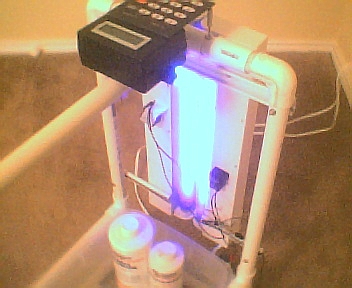Etchlab [Under Development] | |||
| <<< Home | Concept Diagrams | Latest Stage | Links >>> |
| Abstract | <<< Back |
 |
The circuit board Etchlab Project is the most elaborate project done here since the alarm system that involved projects 5, 7, 11, and 15. The goal is provide a development bed for photo-etchable circuit boards. On completion, the autonomous project will be able to expose, develop, etch, and wash working circuit boards, without human intervention from start to finish. It's a combination of electrical, software, mechanical, thermal, and chemical systems that will make this possible. |
| Concept |
ConceptThe chart shows the general device net for the system. The interface is the "standard-issue" LCD Character display and 4x4 keypad as seen in the Aegis system. I'm also experimenting with a serial PC data link that will allow the Etchlab to be controlled and possibly reprogrammed from an adjacent PC. 
The electromechanicals are the most difficult part because the presence of the highly-corrosive Ferric Chloride will make metal pumps and valves truly unusable. The presence of both high-voltage UV lamps and fluids make safety and spill detection a number-one priority. |
| Latest Stage |
Development ProgressPhysically, the Etchlab's skeletal framework is partially complete and sturdy enough to house the UV exposure lamps, chemical tanks, electronics, and fluids. The white frames consist of a PCV structure of pipes and connectors arranged to support the major components. The design is larger and stronger than my previous attempt, which used mostly threaded rods to hold parts in place. Some of the old components, such as an aquarium air pump and several feet of clear tubing are still around--ready to be implemented.  The interface software is just getting started, however since the interface is nearly identical to the previous Secure Monitor project, few of the input/output routines will have to be written from scratch. Electro-mechanical controls will be switches with relays, MOSFET push-pull switches and bipolar amplifiers--depending on the expected power demands. It also interfaces to a PC for remote operation and data logging using a serial port. I'm in the process of building a QBasic interface program, but for now the system works with Hyperterminal. All development chemicals have been purchased and are in safe storage. This includes Ferric Chloride, Sodium Hydroxide, and distilled water for cleaning. Electro-mechanicals are being pursued. Currently, I am in search of five fluid pumps to use for fluid draining and delivery. Thanks to auto salvage yards, I should have these in supply within this month, January 2006. I'm also in the process of designing an electric heater to pre-heat the Ferric Chloride supply for faster and more uniform etching. The heating rod with radiate 30 Watts of power into the holding tank. As a possible side-project, I'm researching the web to see if it is possible to remove --one way or another--the copper salts that result from etching. The processes is optional, but it would allow the chemical etchants to be recycled in greater quantities. 
Interfacing with the PCTo reiterate, this is also a PC interface project that will attempt to link the AVR microcontroller to a Windows PC. This is being done thanks to RS-232/TTL conversion and the internal UART included inside the ATMEGA8515 microcontroller. Currently, the central controller communicates with the PC through a terminal program, however by the end of the project I hope to use a more specialized program similar to the one shown here. The screen can even be reddened for limited use in the darkroom. The remote operation feature will help log the etch tank temperature and eventually allow me to find an optimal production temperature. It will also feature a remote terminal feature that can active the Etchlab's various motors and fluid pumps individually for test purposes. |